The Wonderful World of Snakes
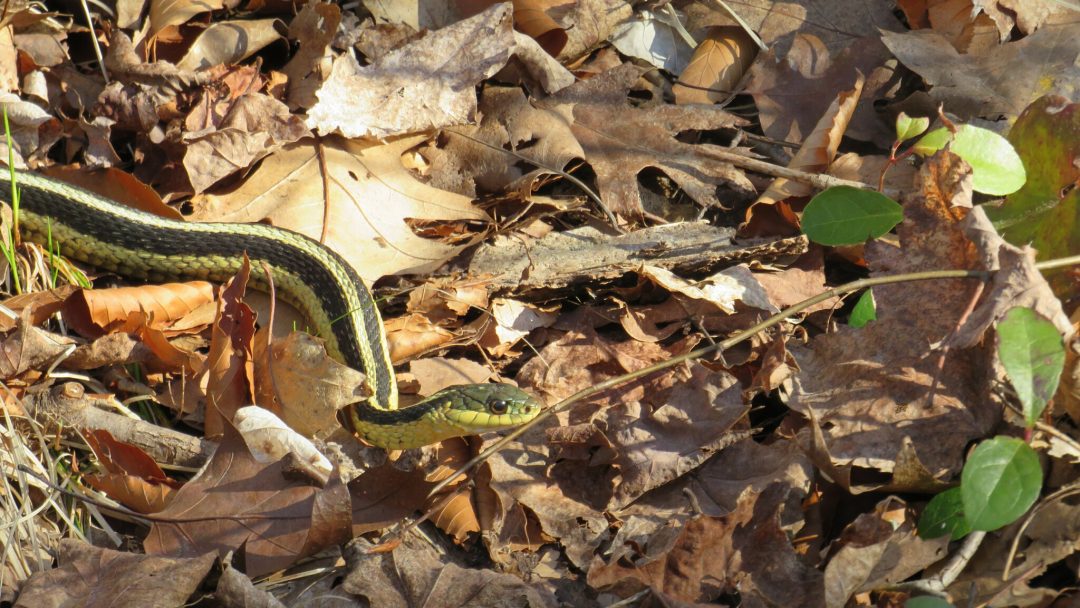
What are snakes?
Snakes are legless reptiles within the suborder Serpentes. Snakes and lizards are both in the order Squamata, and it is believed that snakes may have evolved from a lineage of lizards, losing their legs, eyelids, and external ear openings through the long process of evolution. Snakes are a diverse group, with 3,400 species ranging in size from 10-meter-long reticulated pythons to 10.4-centimeter-long barbados threadsnakes (Peters & Wallach, 2024; Rafferty, 2016). Like all species, snakes contribute to biodiversity and ecosystem resilience in places where they live.
Why are snakes important?
Snakes play many important roles in their ecosystems. Snakes are predatory animals, and help to control the populations of their prey. This prey can range from worms and insects to mice to large mammals, and even other snakes (Britannica, 2024; Peters & Wallach, 2024; Rafferty, 2024). In turn, snakes are preyed upon by many animals, such as foxes, raccoons, and birds (Encyclopædia Britannica, inc.). While snakes may not be as appealing to many people as charismatic species like deer and birds, their ecological roles are just as important, and disrupting snake populations can have devastating impacts on entire ecosystems.
One example of the ecological benefits of snakes for humans in particular is their impact on tick populations. While snakes are unlikely to prey on ticks directly, they can contribute to reducing tick populations through the animals that they do prey on. Mice are a crucial part of the tick life cycle, as they provide the first blood meal to larval ticks. Mice populations often benefit when ecosystems are disturbed by human activity, as they are more able to adapt to disturbances than many of their predators. This increase in mice populations can lead to increased tick populations, putting humans living in these areas at higher risk of tick-borne diseases like Lyme disease. However, healthy snake populations can help to reduce these out-of-control mice populations, particularly larger snake species like milksnakes, foxsnakes, and ratsnakes. Protecting snake species and restoring their habitat can reverse this trend and keep people safer from disease (Brown, 2021).
In Ontario, many of our snake species are in jeopardy. Over half of the snake species in Ontario are at risk or endangered, and almost all of Ontario’s snakes have significantly reduced ranges. Many snake species, such as queensnakes and gray ratsnakes, can only be found in isolated pockets of intact habitat. Habitat destruction and fragmentation are the main factors leading to this decline, but persecution by misinformed people is also a threat (Swann, 2021). Furthermore, prejudices against snakes can impede conservation efforts. Snake populations across Ontario need our help to preserve and restore healthy habitat and teach people about the importance of snakes to our ecosystems.
Common snake misconceptions:
Snakes are deadly – out of the 3,400 species of snakes in the world, only about 300 are venomous, and only about 150 have enough venom to kill a person. Venomous snakes can also control how much venom they inject when they bite, and may not inject any venom whatsoever when biting a human. Additionally, even snake bites from snakes with enough venom to kill a person can be survived with proper medical treatment. Finally, snakes only bite humans when they feel threatened. A snake will never attack a person unless it feels that the person was a threat to its survival (Peters & Wallach, 2024). In Ontario, the last death by venomous snake bite was over 50 years ago (Government of Ontario 2023).
Snakes are slimy – snakes, like all reptiles, have scales covering their skin. Rather than being slimy, snake scales are actually smooth and dry. While snakes may appear slimy if they have recently been in water or damp soil, they do not produce their own “slime” like amphibians do.
Snakes will chase you and attack unprovoked – many people may attempt to avoid all encounters with snakes, even in areas where there are no venomous snakes, based on a fear that snakes will chase or attack them if they get close. However, this fear is largely unfounded. Snakes will never chase or attack a human unless they feel provoked. The vast majority of snake species will attempt to find the quickest escape route out of an encounter with a human, and will only display aggressive behaviour if they feel they have no alternative. In some instances, a snake may appear to chase a person if it thinks that the safest escape route is in the same direction as the person, but snakes will not intentionally approach a person if they can avoid it (Creative Victoria).
Hamilton’s snakes
Hamilton is home to eight species of snakes, with five species commonly found in and around the McMaster University campus. None of the snake species in the Hamilton area are venomous. Get to know our local snakes through the information below!
Found on or near campus:
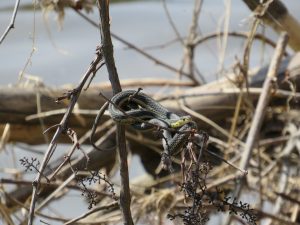
Eastern Garter Snake (Thamnophis sirtalis sirtalis): Eastern garter snakes are the most common snake species in the Hamilton area, and the most widespread species in Ontario. They are tolerant of human-modified conditions, and can be found in urban areas provided there is enough greenspace to support their food requirements. These colourful snakes are highly variable in their patterning, with checkerspots, stripes, and bars in black, grey, blue, brown, yellow, and orange colours. However, they can be easily identified by the distinct yellow line running all the way along their back, the yellow lines on each side, and their yellow (rather than white) chin. Eastern garter snake females are much larger than males, and can grow up to 80 centimeters in length. These snakes typically give birth to 15 to 20 live young in mid to late summer. Eastern garter snakes eat a variety of prey, from worms to fish and frogs.
Recent research has suggested that garter snakes may form social groups. This research, which was done on Butler’s garter snakes (Thamnophis butleri), noted that snakes were found to consistently associate with certain other snakes more than average. Furthermore, groups of snakes that tended to associate with each other were centered around older female snakes. Younger snakes were found to “follow” older snakes around, showing up in the same place as these older females after they had been there for some time. These snakes tended to associate with other snakes of similar ages, and more social snakes also tended to be healthier. While these observations were not on the garter snake species found in Hamilton, similar behaviour may be present in local garter snakes as well (Howlett, 2023).
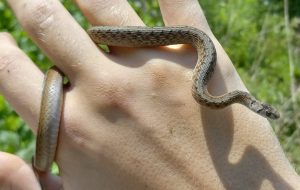
Dekay’s Brownsnake (Storeria dekayii): Dekay’s brownsnakes are another common snake in the Hamilton area. They are smaller snakes, growing up to about 30 centimeters in length. They are generally tan or light brown, with a paler band along their back bordered by a darker brown line or line of spots. These snakes are also identified by the dark brown line behind each eye. Dekay’s brownsnakes are often found sheltering under logs and rocks, and may also be found in piles of garbage or wood. This species feeds on a variety of arthropods, such as worms and slugs. Dekay’s brownsnakes breed in spring and autumn, and give birth to live young.

Northern Watersnake: (Nerodia sipedon sipedon): Northern watersnakes are another common species in the Hamilton area, though they are rarely found far from water bodies. Northern watersnakes are thick-bodied snakes, and can grow up to a meter in length. They can be identified by their dark grey-brown colouration, with dark, wavy brown or grey bands along their bodies. These snakes are skilled aquatic predators, catching and feeding on fish, frogs, and tadpoles. This species is most often observed basking on logs or rocks at the water’s edge. Northern watersnakes are quick to bite when threatened, and are best observed from a respectful distance. Like garter snakes, this species also gives birth to live young.
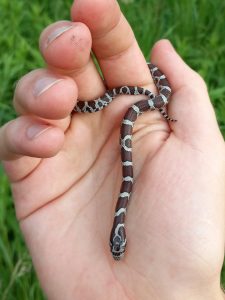
Eastern Milksnake (Lampropeltis triangulum): Eastern milksnakes are a somewhat uncommon, mid-sized snake species in the Hamilton area. Adults are typically around 90 centimeters in length, but they may grow to more than a meter. This species can be identified by its light grey colouration and reddish-brown blotches with distinct black borders, as well as the Y-shaped blotch on the back of its head. These snakes are diurnal, and so may be found on the move in their preferred habitats (fields and forest edges) throughout the day. Eastern milksnakes have a unique diet, with juveniles mainly feeding on other snakes, while adults feed on small mammals, birds, as well as other snakes. Another unique behaviour of this snake is its rattling. While they are not a rattlesnake, Eastern milksnakes often vibrate their tails when threatened to mimic the sound of a rattlesnake’s tail. This species is also unique from most other common species in Hamilton in that it has smooth scales, rather than keeled scales (scales with a ridge in the middle). Eastern milksnakes breed in spring, and lay eggs in early summer. These eggs are laid in rotting logs or small mammal burrows.
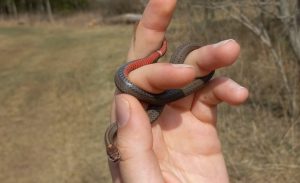
Red-bellied Snake (Storeria occipitomaculata): Red-bellied snakes are the smallest snake species in Ontario, reaching only 24-28 centimetres in length as adults. They vary from grey, to brown, to black with two dark stripes along their back and two along the side. The easiest feature to identify these snakes by is their striking bright red or red-orange belly. These snakes feed on small soft arthropods; mainly slugs, snails, and worms. Red-bellied snakes give birth to live young, and breed in spring and autumn.
Found in the Hamilton area:
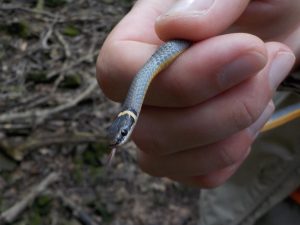
Ring-necked Snake (Diadophus punctatus edwardsii): Ring-necked snakes are a small, colourful snake species that are easily identified by their dark grey to black body with an orange ring behind their head and bright orange belly. These snakes are nocturnal, and so are rarely seen as they hide under rocks and logs during the day. They mainly feed on salamanders (particularly on the Eastern Red-backed Salamander in Ontario), as well as worms, slugs, snails, and other snakes. This snake is also technically venomous, as it can produce mild venom with small fangs at the back of the mouth. However, these snakes rarely attempt to bite and are also usually too small to successfully bite humans, so they are considered harmless. This species breeds in spring and autumn and lays eggs in decaying logs or under rocks.
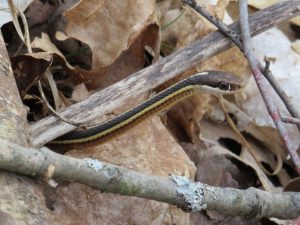
Eastern Ribbon Snake (Thamnophis saurita): Eastern ribbon snakes are mid-sized, slender snakes, about the same size as eastern garter snakes. They are also visually similar to eastern garter snakes, with brown bodies and yellow stripes. However, they can be distinguished from eastern garter snakes by their white chin and the white crescent in front of their eyes. Additionally, the patterning on eastern ribbon snakes tends to be more distinct and sharper. Eastern ribbon snakes mate in spring after emerging from overwintering sites, and give birth to live young in late summer. These snakes live near water, and are rarely found more than a few meters away from a water body. As such, this species feeds on wetland prey like frogs.
(All photos by Jonathan Scholtens. All snake profiles derived from the Ontario Nature Reptile and Amphibian Atlas 2009-2019)
References:
Britannica, The Editors of Encyclopaedia (2024, February 9). king snake. Encyclopedia Britannica. https://www.britannica.com/animal/king-snake
Brown, D. (2021, April 5). Wildlife allies prevent ticks and limit lyme disease. Huron River Watershed Council. https://www.hrwc.org/wildlife-allies-ticks-lyme-disease/
Creative Victoria. (n.d.). Eight myths about snakes. Museums Victoria. https://museumsvictoria.com.au/article/8-myths-about-snakes/
Encyclopædia Britannica, inc. (n.d.). snake. Encyclopædia Britannica. https://kids.britannica.com/students/article/snake/277103
Howlett, J. (2023, December 15). Garter snakes make friends, organize their society around females. Science.org. https://www.science.org/content/article/garter-snakes-make-friends-organize-their-society-around-females
Massasauga rattlesnake. Government of Ontario. ontario.ca. (2023, December 21). https://www.ontario.ca/page/massasauga-rattlesnake
ORAA. 2023. Ontario Reptile and Amphibian Atlas, 2009 – 2019. Ontario Nature, Toronto. 443 pp.
Peters, James A. and Wallach, Van. “snake”. Encyclopedia Britannica, 29 May. 2024, https://www.britannica.com/animal/snake. Accessed 7 June 2024.
Rafferty, J. P. “Barbados threadsnake”. Encyclopedia Britannica, 28 Nov. 2016, https://www.britannica.com/animal/Barbados-threadsnake. Accessed 7 June 2024.
Rafferty, J. P. (2024, June 8). reticulated python. Encyclopedia Britannica. https://www.britannica.com/animal/reticulated-python
Swann, A. (2021). An introduction to ontario’s snakes. NCC: Land Lines. https://www.natureconservancy.ca/en/blog/archive/an-introduction-to-ontarios-snakes.html
Nature Stories